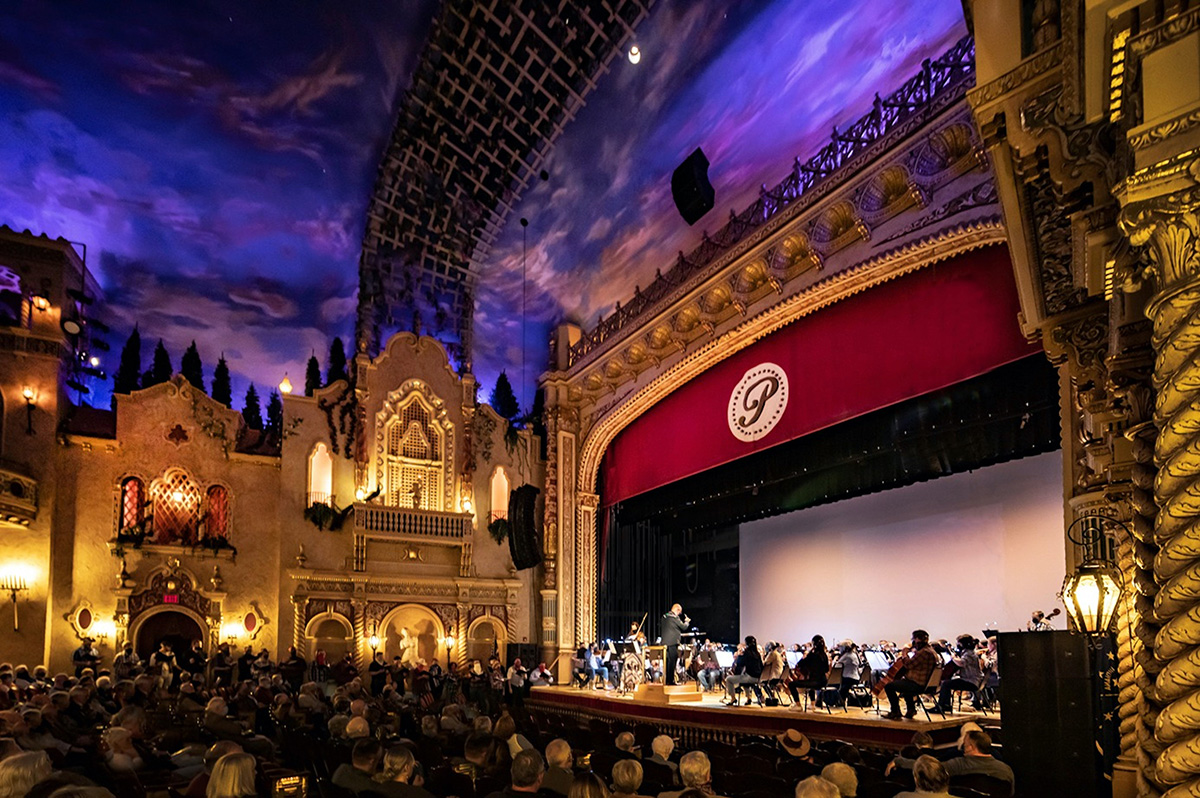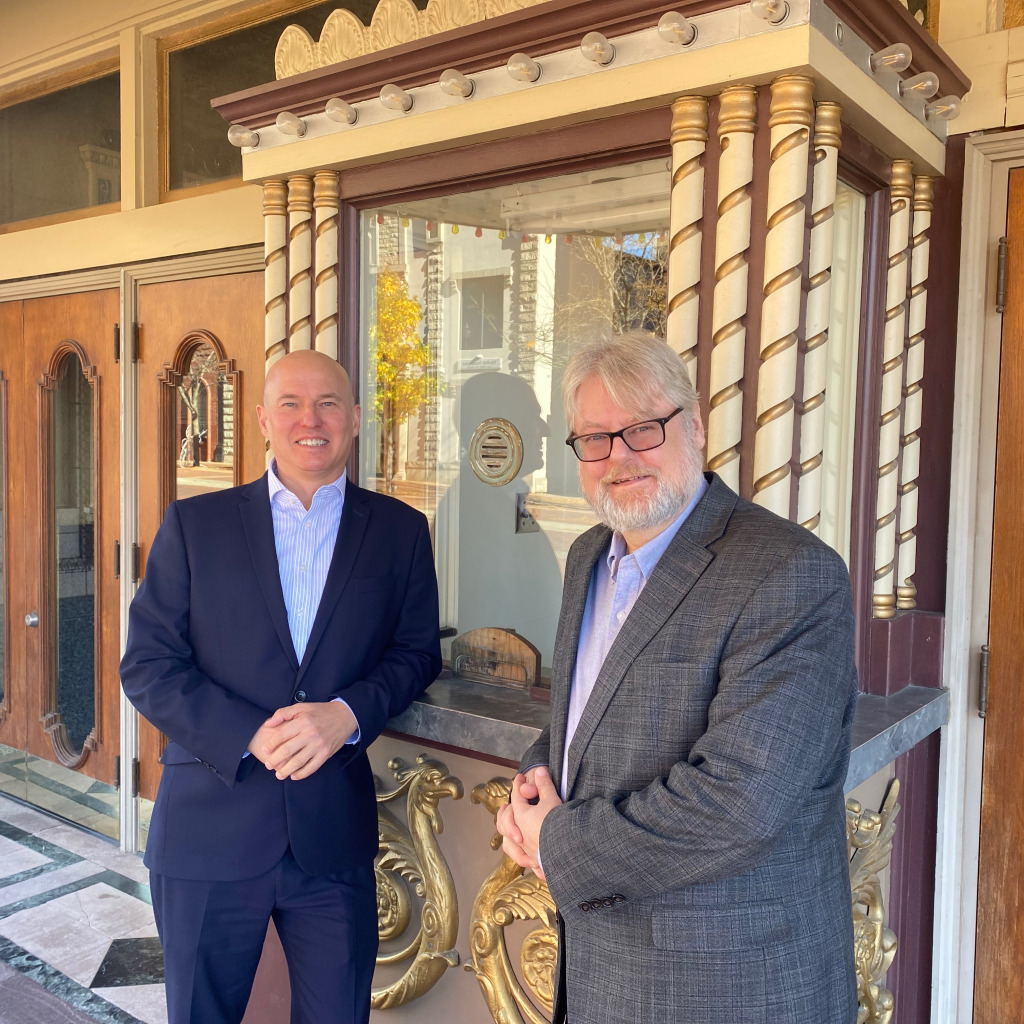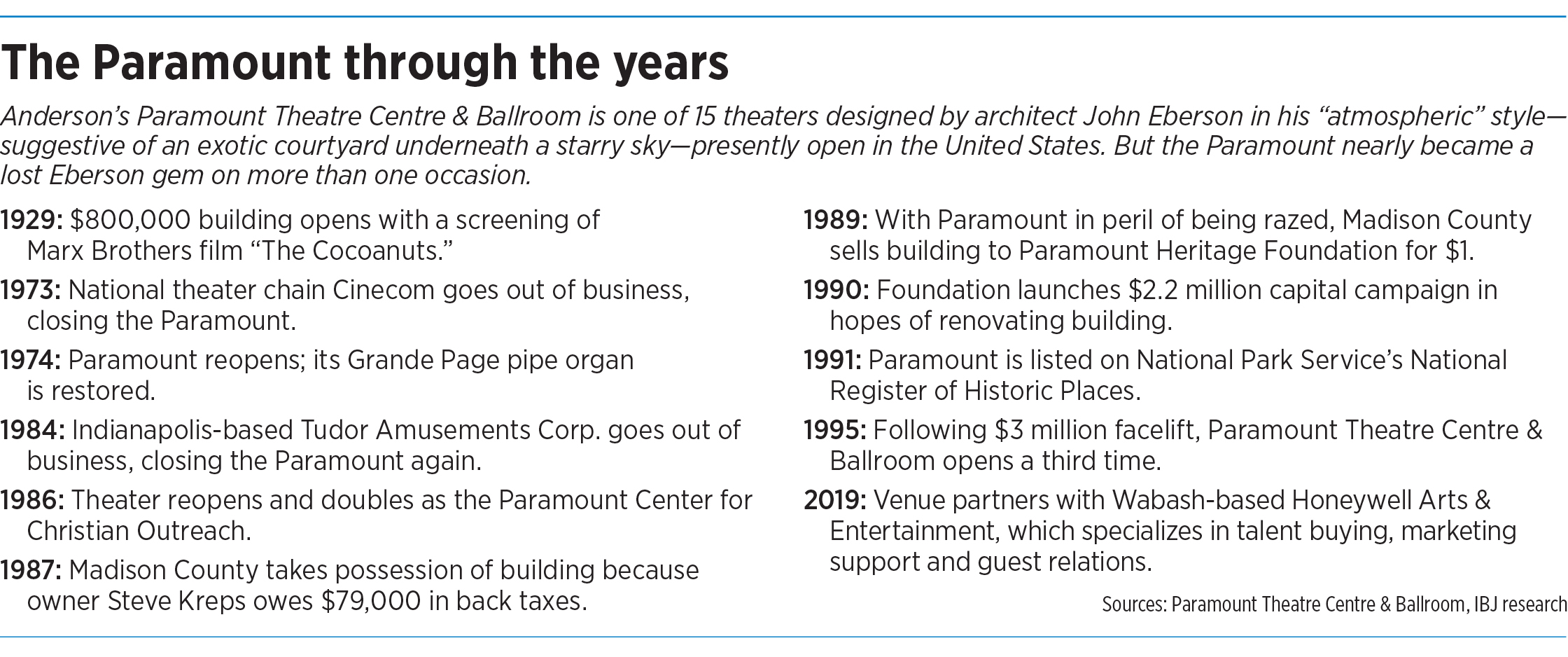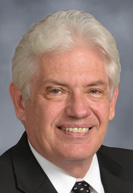Subscriber Benefit
As a subscriber you can listen to articles at work, in the car, or while you work out. Subscribe NowAlthough Rich Jorn has been on the job as executive director of the Paramount Theatre Centre & Ballroom for just two months, he sounds like a longtime caretaker when he raves about the downtown Anderson landmark.
The Paramount has a way of playing with time, which Jorn notes when describing the modern-day experience of visiting the theater that opened 94 years ago with a screening of the Marx Brothers film “The Cocoanuts.”
“If you were a resident of the booming town of Anderson, Indiana, in 1929 and you were putting on your Sunday best to come out to the grand opening of the beautiful Paramount Theatre, this is what it would look like,” said Jorn, standing in the venue’s balcony while surveying statues of Greek and Roman goddesses, flower-covered trellises and facades of Spanish villas that decorate the room.
The Paramount is one of 15 “atmospheric” theaters designed by John Eberson still in use in the United States. Born in Romania, Eberson designed nearly 100 atmospheric movie palaces—each featuring an arched blue ceiling and the suggestion of taking in a show under a starry sky.
“The decor, the color, the ceiling … every detail—this is exactly what it would have been like,” Jorn said.
The Paramount nearly was razed in 1989 to make way for a parking lot, but it survived to show off an opulent restoration when reopening in 1995.

Through a partnership with Wabash-based Honeywell Arts & Entertainment, the Paramount is enjoying a resurgence worthy of the venue’s sparkling appearance. Since 2019, Honeywell Arts & Entertainment has provided services such as talent buying, guest relations and marketing support.
Following an era of diminished star power at the Paramount, notable names are showing up on the marquee: Buddy Guy, Melissa Etheridge and Kenny Wayne Shepherd among them.
The Honeywell organization works in a similar capacity with other venues in the Midwest, including South Bend’s Morris Performing Arts Center and Veterans Memorial Civic & Convention Center in Lima, Ohio.
But it’s difficult to stack up to the Paramount.
“It’s a lot to take in,” said Tod Minnich, Honeywell Arts & Entertainment CEO. “The experience of seeing this theater alone is worth the concert ticket price.”
When crowds come out to the 1,450-capacity venue, Minnich said, the Paramount offers the hope of being a catalyst for economic development in Anderson.
“For us, it’s more than just another place to promote concerts,” Minnich said. “We see the value of what can happen with a theater like this and the impact it can have on a community.”

Anderson, where the population decreased from 70,000 in 1970 to 55,000 in 2020, has struggled in comeback mode since local General Motors plants started to shut down in the 1980s and finally exited completely in 2007.
Jorn and Minnich report that 70% of ticket buyers travel from outside Madison County to attend events at the Paramount, making the venue a welcomed bright spot on Anderson’s economic landscape.
Clayton Whitson, CEO of the Madison County Chamber of Commerce, said authenticity is part of the Paramount’s appeal.
“Other communities have to build places and try to make them look old,” Whitson said. “Unlike Carmel and the Palladium, we have the original. What the Paramount has seen going back to the 1920s is truly remarkable. It’s such an honor to have a gem of a venue right here in our hometown.”
In addition to hosting performances by the Anderson Symphony Orchestra and Anderson Young Ballet Theatre Inc., the Paramount has a goal of ramping up to 40 to 50 annual dates for touring shows scheduled in conjunction with Honeywell.
Jorn looks across the street from the Paramount, 1124 Meridian Plaza, and predicts new life for an abandoned downtown storefront.
“In time, somebody’s going to say, ‘I’m going to put a restaurant there because every weekend the Paramount is full and people are looking for a place to eat,’” he said.
Rescued palace
Anderson Mayor Thomas Broderick Jr., who won a tight race last month to be reelected to a third term, remembers being a youngster and catching discount movies at the Paramount.
By that time, the architectural marvel that once was a tour stop for Louis Armstrong, Roy Rogers, Cab Calloway and other celebrities revealed plenty of “wear and tear,” Broderick said. A leaky roof attacked the illusion of Paramount’s interior sky filled with twinkling stars.
The building that carried an $800,000 price tag in 1929 seemed to be a goner at age 70. Madison County took possession of the Paramount because an owner in the 1980s owed $79,000 in back taxes.
Broderick credits a group of Anderson residents who formed the not-for-profit Paramount Heritage Foundation Inc. with rescuing the theater from demise. The county sold the building to the foundation for just $1 in 1989.
“Think back to the folks who had the insight and vision to save it rather than let it go by the way of the wrecking ball,” Broderick said. “You can’t say enough about them and all of the folks who have stepped up to keep it where it is today. I firmly believe it will be here for easily another 100-plus years, because I don’t think anybody will ever let it go away.”
Jim Abraham, one of the early leaders of the Paramount Heritage Foundation, oversaw a $3 million renovation of the Paramount in the 1990s. Abraham left Anderson after the theater reopened, but he’s returned and again holds the title of restoration manager.
In 2018, a not-for-profit founded by Jay and Nancy Ricker—former owners of Ricker Oil—donated $500,000 to pay off what remained on the building’s mortgage.
Brittany Miller, eastern regional director for Indiana Landmarks, said she sees the sustained commitment of the Paramount Heritage Foundation.
“The Paramount is something Anderson can be proud of, and I think the group wants to keep that going,” Miller said. “They didn’t want the restoration to be a partial job or an instance of, ‘Oh, this is nice, but it could be better,’ or, ‘We saved the outside, but we didn’t do anything with the inside.’”
Broderick said Anderson’s present challenges include a shortage of attractive housing and an aging water infrastructure.
“For a lot of communities our size, the growth kind of went toward the interstates,” Broderick said. “We’ve been trying to revitalize the downtown for a while now, and we’re getting some traction. Having the Paramount as an anchor really helps, because when they light up that marquee, nothing looks neater than that.”

Jorn, the Paramount’s executive director who previously managed the RiverPark Center entertainment venue in Owensboro, Kentucky, said efforts to improve the Paramount are ongoing.
A new floor was installed on the theater’s stage in recent years, and handrails are slated to be added to the balcony to assist attendees as they navigate stairs.
The Paramount Heritage Foundation also owns a former office building behind the theater, which Jorn would like to renovate with backstage amenities that connect to the Paramount.
The theater’s design placed dressing rooms below the stage, and showers weren’t part of the plan. For productions that require a performer to exit one side of the stage and enter on the other, the only path is below the stage.
“It’s now up to us to raise the money to turn the [backstage building] into adequate dressing room space that will have showers and all the up-to-date amenities that bands would want,” Jorn said. “People want to play here because it’s the Paramount. But it’s not the most comfortable.”
Honeywell Arts & Entertainment, a not-for-profit in Wabash that owns seven venues, operates as an independent concert promoter that rarely competes with industry giants Live Nation and AEG Presents, Minnich said.
By partnering with venues such as the Paramount, Honeywell has the ability to offer booking agents multiple cities where a tour can visit. In February, the Little River Band is set to play Honeywell-promoted dates at the Honeywell Center in Wabash and Morris venue in South Bend.
Minnich said his organization has consistent success when hiring classic rock, country and comedy acts. Tribute acts, meanwhile, represent a surging segment of business.
The 2024 calendar at the Paramount includes tribute acts performing songs popularized by the Beatles, ABBA, Billy Joel and Elton John, and Queen. Ace Frehley is headed to Anderson for a Jan. 26 show at the Paramount, and a March 15 performance by Travis Tritt is nearing sellout status.
“People always ask how we get these acts to come,” Minnich said. “We write them a check. It’s a business of being able to find the right date and the right fee that works.”
Competition for hiring acts is on the way. An 1,800-capacity music venue is under construction in Gas City, a community of 6,000 residents 30 miles north of Anderson and 25 miles southeast of Wabash.
Minnich and Jorn said they welcome new venues to Indiana.
“There’s plenty of audience to go around,” Minnich said. “The populations in these areas are significant. The bigger challenge we see is that there’s only so many artist dates. An artist isn’t going to play Anderson and Gas City or Gas City and Wabash.”
Escape from reality
Architect Eberson wanted his atmospheric theaters to provide shifts in perception.
In the 1981 book “American Picture Palaces,” Eberson was quoted as saying, “We visualize and dream a magnificent amphitheater, an Italian garden, a Persian Court, a Spanish patio or a mystic Egyptian temple yard, all canopied by a soft moonlit sky.”
What Anderson preserved with the Paramount, cities ranging from Oklahoma City and Tulsa to Pittsburgh and Gary lost when Eberson-designed atmospheric theaters were demolished. Chicago’s Paradise Theatre, in business from 1928 to 1956, inspired 1981 album “Paradise Theatre” by rock band Styx.
Indiana is home to two still-active Eberson atmospherics: Terre Haute’s Indiana Theatre and the Paramount.
Visitors to the Indiana Roof Ballroom in downtown Indianapolis will note that architects Preston Rubush and Edgar Hunter drew on atmospheric influences—a starry night sky above stucco European building facades—similar to what motivated Eberson in the 1920s.
The Paramount is home to one more old-time attraction, a Grande Page pipe organ, that places the venue in rare company. Just four buildings in the United States continue to maintain this style of organ in the original setting: the Catalina Casino on California’s Santa Catalina Island, the State Theatre in Sandusky, Ohio (presently closed because of severe weather damage in 2021), Fort Wayne’s Embassy Theatre and the Paramount.

“Not everyone is as lucky to be able to go to these theaters and have experiences there,” said Miller, the Indiana Landmarks executive based in Richmond. “For modern audiences, I think it’s something that people don’t realize they’re missing out on.”
Miller described a visit to an Eberson-designed atmospheric theater as an escape from reality.
“As you’re sitting and you’re looking around, it can be hard to pay attention to the show because you’re distracted by everything that’s in the theater,” she said. “Small details can make you feel like you’re being transported to another place.”
Jorn and Minnich said they’re happy to see people from the northeastern suburbs of Indianapolis make the relatively short trip to the Paramount.
Before the theater reopened, the populations of Fishers and Noblesville were a combined 25,000 in 1990. Today, Fishers and Noblesville are cities of 104,000 and 72,000, respectively.
Minnich makes a case for affordable parking and easy access in downtown Anderson.
“Everything that plays here plays other places,” Minnich said. “But audiences for concerts travel. The Paramount is a place where you can see one of your favorite artists and have an experience that’s really unlike most theaters in the country.”•
Please enable JavaScript to view this content.


